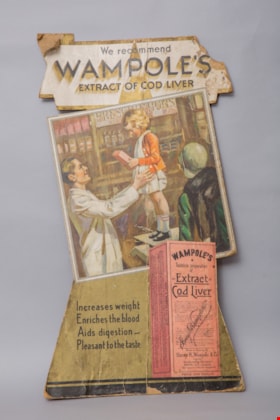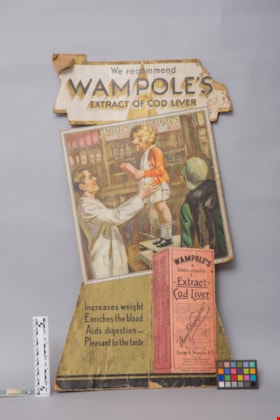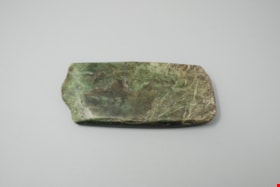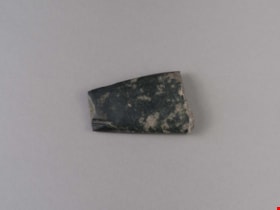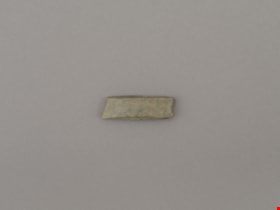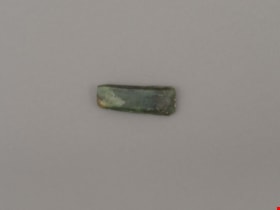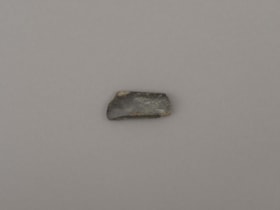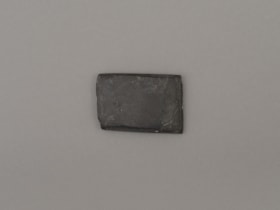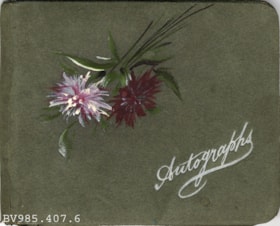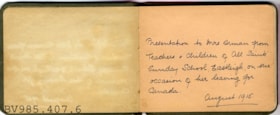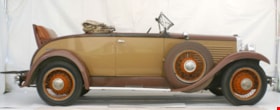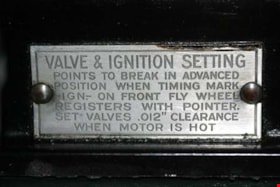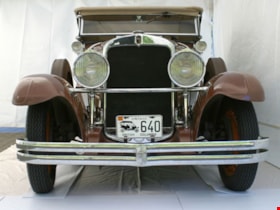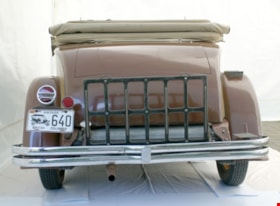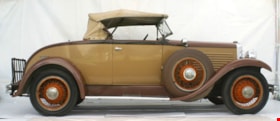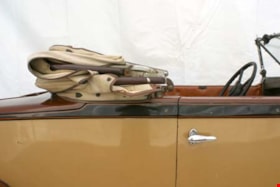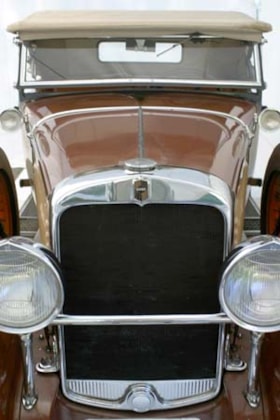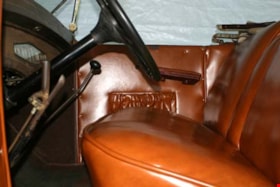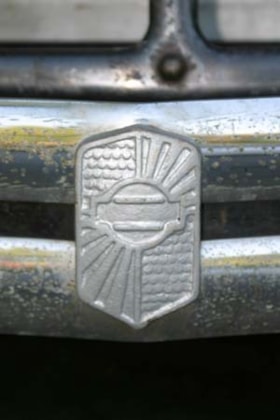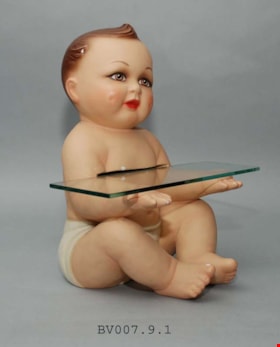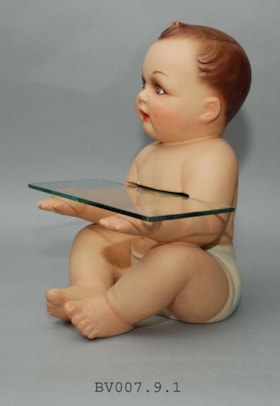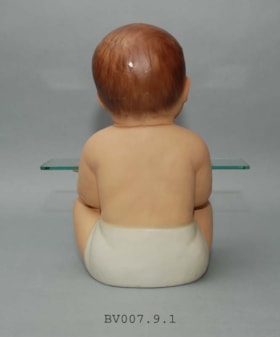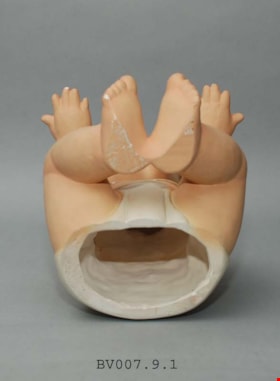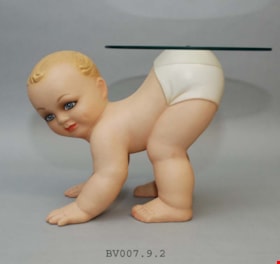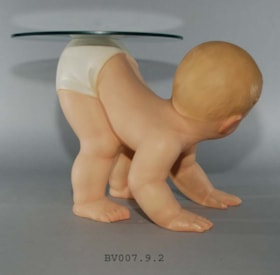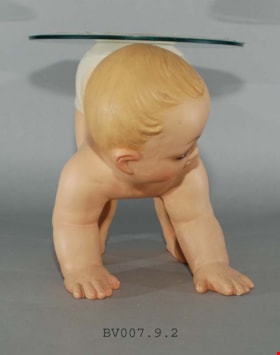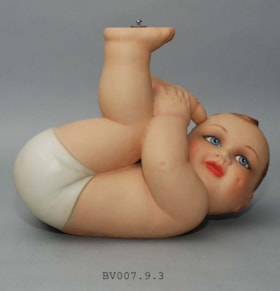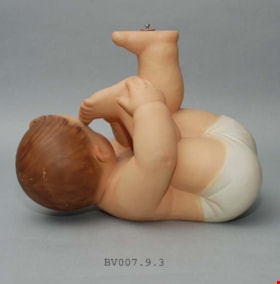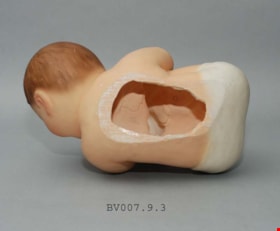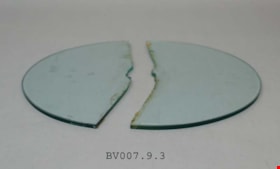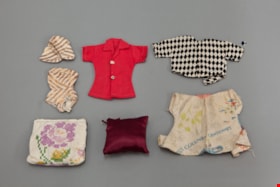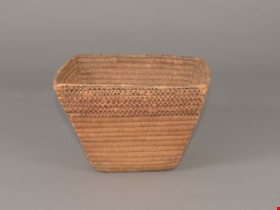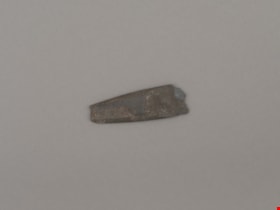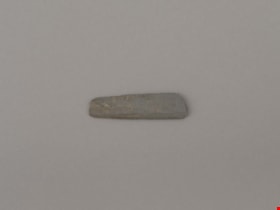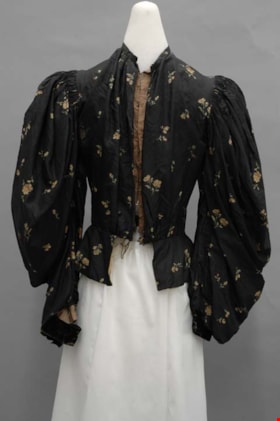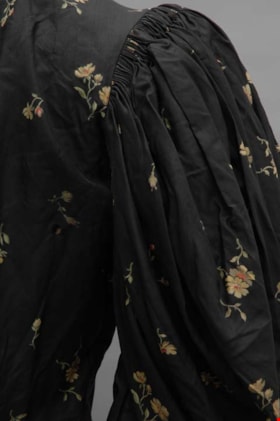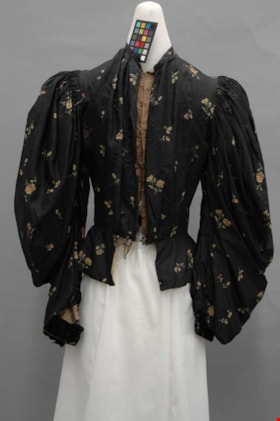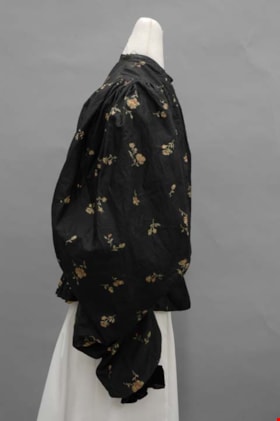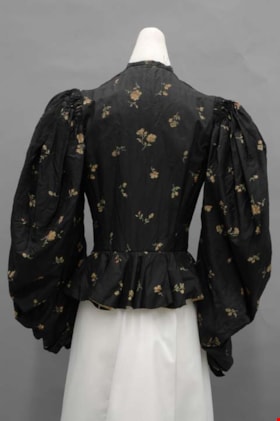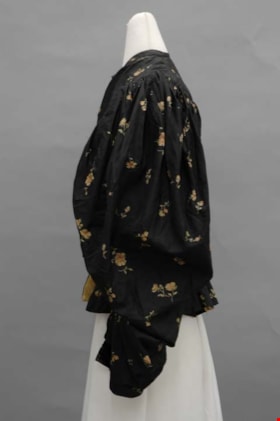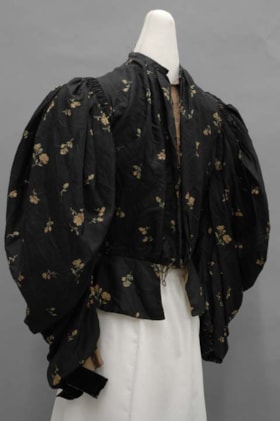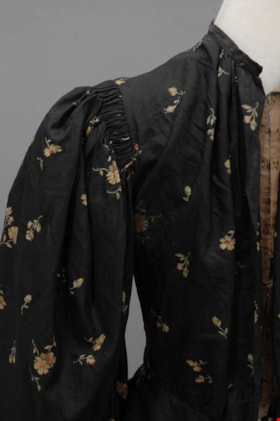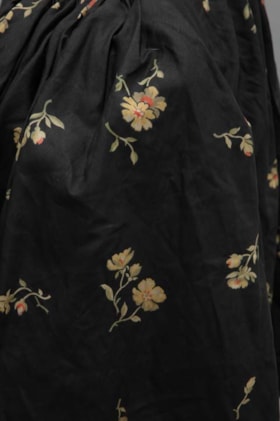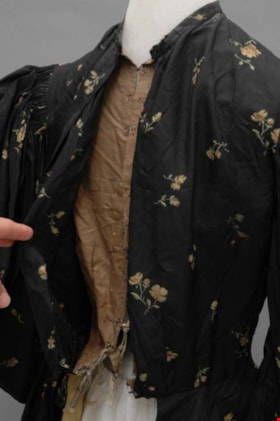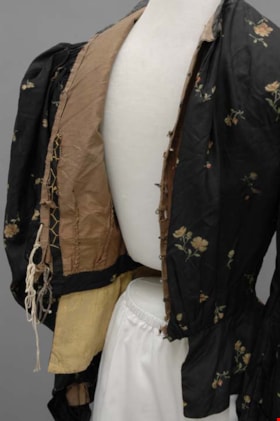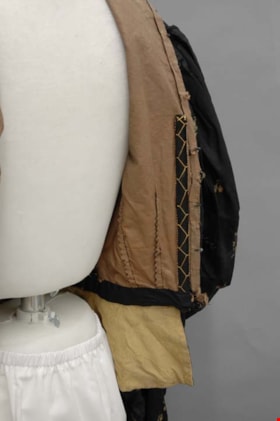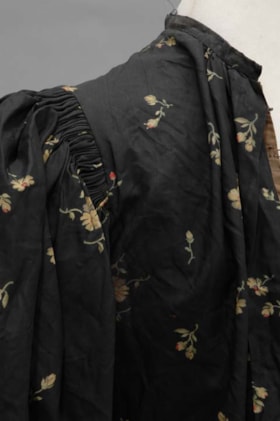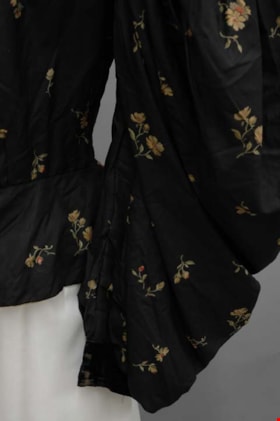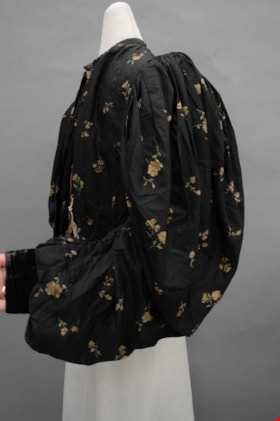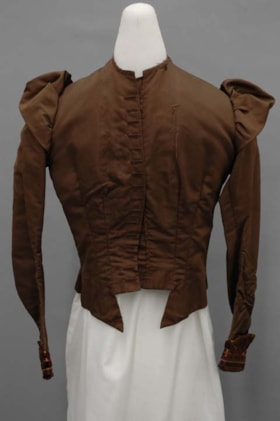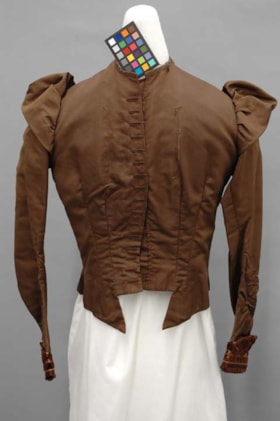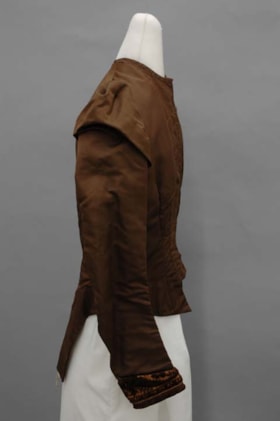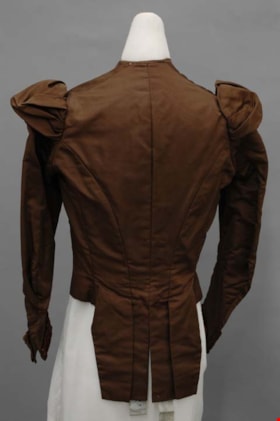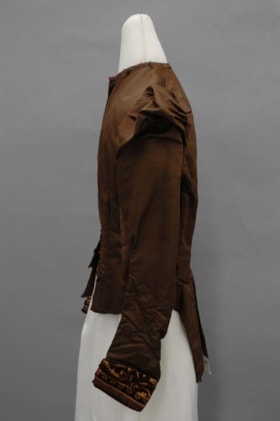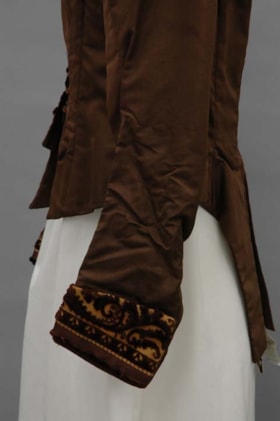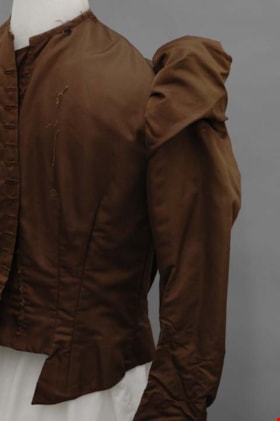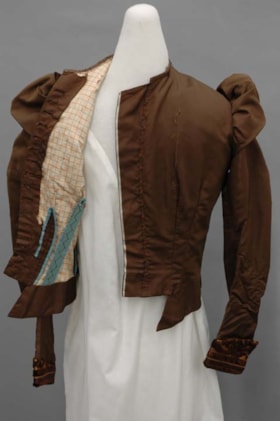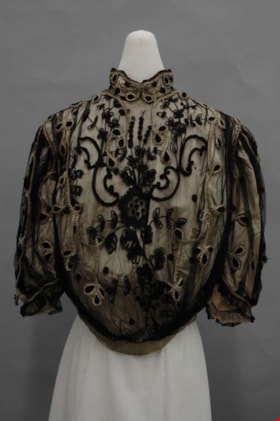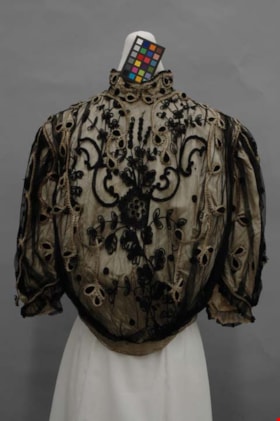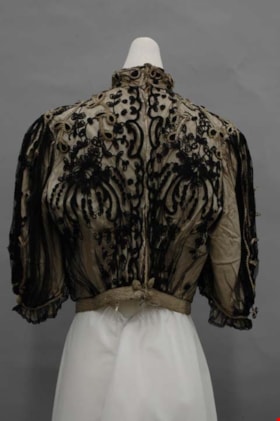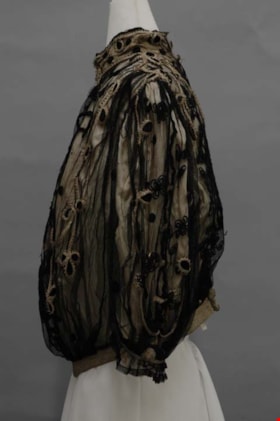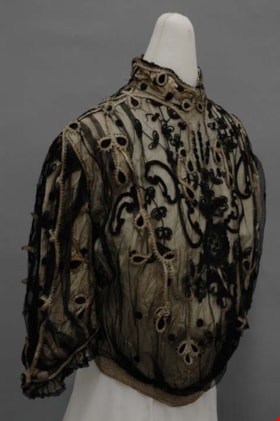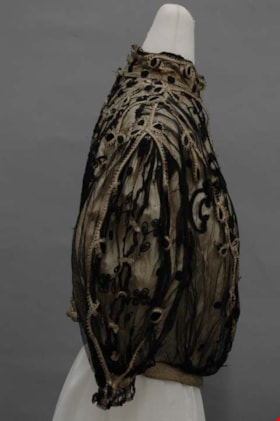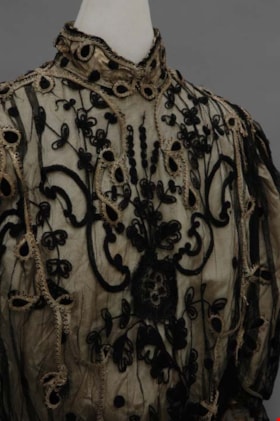Narrow Results By
Subject
- Advertising Medium - Signs and Signboards 1
- Archeological Specimen 31
- Armament 16
- Clothing 23
- Clothing - Costumes 23
- Communication Artifacts 1
- Container 4
- Container - Baskets 3
- Documentary Artifacts 16
- Documentary Artifacts - Booklets 4
- Documentary Artifacts - Cards 3
- Documentary Artifacts - Leaflets 1
Person / Organization
- Bateman, Mary Dale 1
- Bayntun, Charmaine "Sherrie" Yanko 2
- Bradley, William Ernest "Bill" 1
- British Columbia Electric Railway Company 1
- Descoteau, Norah Irene Byrne 1
- Helen's Childrens Wear 4
- Hill, Louis Claude "Claude" 31
- Imperial Order Daughters of the Empire 1
- Levins, Catherine Mary Corner 1
- Peers, Robert Claude Kenrick "Bob" 1
- Yanko Family 2
- Yanko, John Ivan 1
advertisement card
https://search.heritageburnaby.ca/link/museumartifact14664
- Repository
- Burnaby Village Museum
- Accession Code
- HV984.37.1
- Description
- advertisement card; cardboard countertop advertisement card for "WAMPOLE'S / EXTRACT OF COD LIVER". There is a cardboard easel stand on the back of the card for support. Advertisement is printed in colour and features a large image of the product box, along with an illustration of a child being weighed by a pharmacist while her mother looks on. The child is holding a carton of Wampole's.
- Classification
- Advertising Media
Images
adze blade
https://search.heritageburnaby.ca/link/museumartifact44868
- Repository
- Burnaby Village Museum
- Accession Code
- BV002.57.19
- Description
- Nephrite adze blade; chipped on one end; rectangular shaped.
- Object History
- The donor inherited this artifact from his mother, Katherine Maude (Kitty) Peers, who inherited them from her father, Louis Claude Hill. The artifacts were found on his farm, Brookfield Farm, at Douglas Road and Sperling Avenue (now site of Burnaby Village Museum).
- Nephrite is found in the Fraser Canyon
- Culture Phase: Possibly Locarno Beach phase (3520-2200 Before Present) or Marpole (400BC - 400AD)
- Historic Neighbourhood
- Burnaby Lake (Historic Neighbourhood)
Images
Documents
adze blade
https://search.heritageburnaby.ca/link/museumartifact44870
- Repository
- Burnaby Village Museum
- Accession Code
- BV002.57.21
- Description
- Chisel, adze or axe blade made of serpentine; black; ends broken off; tapered rectangle shape.
- Object History
- The donor inherited this artifact from his mother, Katherine Maude (Kitty) Peers, who inherited them from her father, Louis Claude Hill. The artifacts were found on his farm, Brookfield Farm, at Douglas Road and Sperling Avenue (now site of Burnaby Village Museum).
- Culture Phase: Locarno Beach (3520-2200 Before Present) or Marpole (400BC - 400AD)
- Historic Neighbourhood
- Burnaby Lake (Historic Neighbourhood)
Images
Documents
adze blade
https://search.heritageburnaby.ca/link/museumartifact44872
- Repository
- Burnaby Village Museum
- Accession Code
- BV002.57.23
- Description
- Chisel, adze or axe blade made of serpentine; small
- Object History
- The donor inherited this artifact from his mother, Katherine Maude (Kitty) Peers, who inherited them from her father, Louis Claude Hill. The artifacts were found on his farm, Brookfield Farm, at Douglas Road and Sperling Avenue (now site of Burnaby Village Museum).
- Culture Phase: Locarno Beach (3520-2200 Before Present) or Marpole (400BC - 400AD)
- Historic Neighbourhood
- Burnaby Lake (Historic Neighbourhood)
Images
Documents
adze blade
https://search.heritageburnaby.ca/link/museumartifact44873
- Repository
- Burnaby Village Museum
- Accession Code
- BV002.57.24
- Description
- Nephrite adze blade; small
- Object History
- The donor inherited this artifact from his mother, Katherine Maude (Kitty) Peers, who inherited them from her father, Louis Claude Hill. The artifacts were found on his farm, Brookfield Farm, at Douglas Road and Sperling Avenue (now site of Burnaby Village Museum).
- Nephrite is found in the Fraser Canyon
- Culture Phase: Locarno Beach (3520-2200 Before Present) or Marpole (400BC - 400AD)
- Historic Neighbourhood
- Burnaby Lake (Historic Neighbourhood)
Images
Documents
adze blade
https://search.heritageburnaby.ca/link/museumartifact44874
- Repository
- Burnaby Village Museum
- Accession Code
- BV002.57.25
- Description
- Adze blade; small; possibly nephrite.
- Object History
- The donor inherited this artifact from his mother, Katherine Maude (Kitty) Peers, who inherited them from her father, Louis Claude Hill. The artifacts were found on his farm, Brookfield Farm, at Douglas Road and Sperling Avenue (now site of Burnaby Village Museum).
- Nephrite is found in the Fraser Canyon
- Culture Phase: Locarno Beach (3520-2200 Before Present) or Marpole (400BC - 400AD)
- Historic Neighbourhood
- Burnaby Lake (Historic Neighbourhood)
Images
Documents
adze blade
https://search.heritageburnaby.ca/link/museumartifact44876
- Repository
- Burnaby Village Museum
- Accession Code
- BV002.57.27
- Description
- Nephrite adze blade; rectangular; chipped on one side; slightly grooved on longer edges.
- Object History
- The donor inherited this artifact from his mother, Katherine Maude (Kitty) Peers, who inherited them from her father, Louis Claude Hill. The artifacts were found on his farm, Brookfield Farm, at Douglas Road and Sperling Avenue (now site of Burnaby Village Museum).
- Nephrite is found in the Fraser Canyon
- Marpole Culture (400BC - 400AD) or Gulf of Georgia Culture (400 AD – 1800); essentially these archaeological materials date to the last 2400 years.
- Historic Neighbourhood
- Burnaby Lake (Historic Neighbourhood)
Images
Documents
autograph book
https://search.heritageburnaby.ca/link/museumartifact7129
- Repository
- Burnaby Village Museum
- Accession Code
- BV985.407.6
- Description
- Autograph Book - Booklet -- [1915]. Autograph book produced by Rose & Co at 44 Above Bar, Southhampton. The book was a gift to Mrs. Orman from the Teachers and Children of All Saints Sunday School, Eastleigh, Southhampton, upon her departure to Canada. The first four pages lists all the teachers and children's names. The front cover of the book is green with two painted purple flowers and "Autographs" embossed in white on the bottom right.
- Object History
- This accession appears to be connected to the Orman family. Ada Leila Orman was born June 2, 1901 in Eastleigh, Hampshire, England. According to the 1915 Census, the Orman family came to Canada in 1911 and settled in Calgary. Father Willoughby Henry Orman is listed there as working as a C.P.R. foreman, while mother Daisy Marie (Harklett) Orman worked at home. Older sister Daisy Hilda (Targett) Orman, worked as a stenographer. At five years old Leila began a long fight with a crippling type of rheumatoid arthritis. By the time she was thirteen, she experienced completely ankylosed joints. Her family travelled all over hoping to find a cure, but to no avail. While living in Calgary, Leila developed an interest in painting, knitting, and composing her own poems. She began writing news articles for the Calgary Daily Herald in the 1930s, and her first sonnet published was in that paper on August 28, 1934. She had a strong interest in the arts, often writing about music and the visual arts. While living in Calgary, she became a member of the Business and Professional Women’s Club as well as a member of the Canadian Author’s Association. Three members of the family moved to B.C. when Willoughby retired, ca. 1938. In the 1940 BC Directory, the family are listed as living at 407 Campbell Street, Burnaby. Willoughby died in Burnaby in 1945. Daisy Marie died in 1955 after living 15 years in Burnaby. Her address at the time of her death is listed as 407 Rosewood Avenue, Burnaby. Leila was living with her at that time. Older sister Daisy Hilda married Edgar Harold Targett in 1922. They moved to B.C. from Alberta some years after the other three members of the family (ca. 1962). Daisy Hilda died in 1972. Her address at the time of her death was 7969 Rosewood Avenue, Burnaby. Leila wrote on a typewriter with two sticks to type out the letters. She was an avid reader and was able to turn the pages with a special stick with elastic bands wound around the ends. Canadian novelist Maida Parlow French became her lifelong friend and encouraged her to write her own autobiography - unfortunately it was never finished. Leila wrote “The Giving Heart” in October of 1948. By 1952, she was writing a column for the British Columbia Saturday Magazine entitled “Across the Board” with the intention of inspiring other “incapacitated folk” to live up to their full potential, “If [she] could reach a few people, and encourage them to reach up and out, [she] should feel the effort well worthwhile.” A member of the St. Alban’s Prayer Healing Fellowship group, Leila wrote the “Christian Manifesto for World Peace” in 1963. The Prayer Group met twice monthly at one of the members’ homes and undertook to pray daily for the sick and for world peace. After Leila’s mother died in 1955, Leila’s friend Jeanie Brown kept house for her and was her constant companion. Jeanie Brown and Leila lived together for over thirteen years until an accident sent Leila to hospital and later to nursing home where she died on February 16, 1976.
Images
automobile
https://search.heritageburnaby.ca/link/museumartifact35075
- Repository
- Burnaby Village Museum
- Accession Code
- BV993.19.1
- Description
- 1929 Nash Roadster, two door convertible with rumble seat. Body colour is two-tone, tan and brown. Wheels are wire spoke, mounting 29 in. X 5.5 in. tube tires. There are spare tires mounted on rims. These are located forward of the side doors. All the wheels have hubcaps. There are no side curtains. The engine is six cylinder with a "Twin Ignition" system. There are two sparkplugs per cylinder.
- Object History
- The Nash roadster was purchased by a private owner in British Columbia after it came out in 1929. In the late 1950s or 1960s the car was purchased from the first owner by William "Graham" Kidd (1922-1984) of Burnaby. The well loved vehicle was nicknamed "Agnes" by it's second owner Graham Kidd. Graham Kidd was the son of William Kidd Sr. (1882-1970) and Helen Kelly Kidd (1894-1977). Graham Kidd was born in Burnaby in 1922 and lived in Burnaby his whole life. Graham's father William Kidd and his mother Helen White Kelly married in North Burnaby in 1917 and moved into a home on Oxford Street. William Kidd opened a hardware store on East Hastings Street Burnaby in 1913 and operated it for twenty years before working for Burrard Brokerage in the 1930s. William and Helen had three children; William Graham Kidd, Margaret Graham "Peggy" (McLaughlin) and Ann (Mercier). In the late 1940s, Graham joined his father William Kidd working for Burrard Brokerage eventually becoming the proprietor of the business in the 1950s. Graham Kidd married Gweneth "Gwen" Anderson and lived in North Burnaby with their three children until he died in 1984. Graham Kidd loved his Nash automobile often going for Sunday drives with the convertible top down with children riding in the rumble seat. Parts for the automobile were hard to come by and the family recalls a neighbour Oscar Johnson helped to keep it in good condition. In the 1970s the Nash roadster was also refurbished and repainted with help from Graham Kidd's neighbour John Prestas. In 1984, after William Kidd died, Gwen Kidd donated the automobile to the Transportation Museum of British Columbia, Cloverdale who in turn donated it to Burnaby Village Museum in 1993.
- Classification
- Land Transportation T&E - - Motor Vehicles
- Object Term
- Automobile
- Marks/Labels
- "B33452", serial number
- "436", model number
- "80981", body number
- Maker
- Nash Motor Company
- Country Made
- United States of America
- Province Made
- Wisconsin
- Site/City Made
- Kenosha
Images
baby figure
https://search.heritageburnaby.ca/link/museumartifact79135
- Repository
- Burnaby Village Museum
- Accession Code
- BV007.9.1
- Description
- Molded plaster baby sitting up holding glass shelf. The baby is seated on the floor and there is a slot across its chest and its hands are turned palm upwards to hold the glass shelf (11 cm. X 34.5 cm). The body is open at the bottom and the chest slot. The figure has painted brown hair, brown eyes and is wearing a white diaper. There are chips on the right big toe, at the edge of the chest slot, edge of hair on the right side, back of the head and ends of the fingers. No makers mark inside.
- Object History
- Made for Helen's Children's Wear in early 1950's by Nettie Trainer, the mother of the store owner, Helen Arnold (nee Trainer). They were handmade. Nettie Trainer was a well known maker of custom figures for commercial displays. Helen's Children's Wear was located at 4142 Hastings Street. Owner Helen Arnold opened the store on East Hastings Street in 1948. She moved to the 4142 Hastings Street location in 1955, and added a landmark neon sign to the building in 1956. The sign featured a girl on a swing, and served as an important landmark in the neighbourhood. The store closed in 2007.
- Measurements
- Overall measurements Lth 25.5 cm. Wth 25.5 cm. Ht 38 cm.
- Subjects
- Furniture
- Furniture - Tables
- Names
- Helen's Childrens Wear
Images
baby figure
https://search.heritageburnaby.ca/link/museumartifact79136
- Repository
- Burnaby Village Museum
- Accession Code
- BV007.9.2
- Description
- Molded plaster baby standing on all fours with a round glass shelf (30.5 cm diameter.) attached to the baby's backside. There are no openings. The figure has painted blonde hair, blue eyes and is wearing a white diaper. The finish is cracked in the top of the hair and the glass is cracked around the screw hole. There are no makers marks visible.
- Object History
- Made for Helen's Children's Wear in early 1950's by Nettie Trainer, the mother of the store owner, Helen Arnold (nee Trainer). They were handmade. Nettie Trainer was a well known maker of custom figures for commercial displays. Helen's Children's Wear was located at 4142 Hastings Street. Owner Helen Arnold opened the store on East Hastings Street in 1948. She moved to the 4142 Hastings Street location in 1955, and added a landmark neon sign to the building in 1956. The sign featured a girl on a swing, and served as an important landmark in the neighbourhood. The store closed in 2007.
- Measurements
- height: 30 cm width: 45 cm depth: 31 cm
- Subjects
- Furniture
- Furniture - Tables
- Names
- Helen's Childrens Wear
Images
baby figure
https://search.heritageburnaby.ca/link/museumartifact79137
- Repository
- Burnaby Village Museum
- Accession Code
- BV007.9.3
- Description
- Molded plaster baby laying on its back with a round glass shelf (30.5 cm diameter.) secured to one raised foot. The glass shelf is broken in two pieces.The body of the figure is hollow and open at the back. The figure has painted brown hair, blue eyes and is wearing a white diaper. Inside the baby there are makers mark "NETTIE'S MFG. / VAN BC / CANADA" stamped in ink on inside of body. "FO 2" written in pencil on inside of body.
- Object History
- Made for Helen's Children's Wear in early 1950's by Nettie Trainer, the mother of the store owner, Helen Arnold (nee Trainer). They were handmade. Nettie Trainer was a well known maker of custom figures for commercial displays. Helen's Children's Wear was located at 4142 Hastings Street. Owner Helen Arnold opened the store on East Hastings Street in 1948. She moved to the 4142 Hastings Street location in 1955, and added a landmark neon sign to the building in 1956. The sign featured a girl on a swing, and served as an important landmark in the neighbourhood. The store closed in 2007.
- Measurements
- Overall measurements Lth 35 cm. Wth 23 cm. Ht 29.5 cm.
- Subjects
- Furniture
- Furniture - Tables
- Names
- Helen's Childrens Wear
Images
Barbie clothes and accessories.
https://search.heritageburnaby.ca/link/museumartifact82623
- Repository
- Burnaby Village Museum
- Accession Code
- BV012.14.159
- Description
- Handmade Barbie clothes and various accessories. Large box contains: a)tray containing various Barbie clothes on hangers b)tray containing various Barbie clothes on hangers c)tray containing various Barbie clothes and wigs on plastic stand d)plastic box containing various Barbie pants and skirts e)plastic box containing various Barbie accessories and baby doll f)plastic box containing various Barbie accessories, including metal tin containing shoes and paper box g)blue floral pattern tin containing Barbie kitchen accessories h)green floral pattern tin containing two small pillows
- Object History
- From the Yanko family home in Burnaby. Barbie clothes made by Lillian Yanko, mother. Barbies belonged to daughters Charmaine and Rhonda Yanko. Annie D. Basiuk (later Yanko) was born on February 25, 1902 in Sheho, Saskatchewan (formerly Sheho, North West Territories). Daniel "Dan" Yanko was born in Kobilnicha, Ukraine in 1887 and immigrated to Canada in May or June of 1905. Daniel Yanko married Annie D. Basiuk and had thirteen children together. Their son, John Ivan Yanko was born on the family farm, near Kelliher, Saskatchewan, on June 27, 1923. In grade six, John was pulled out of school to help support the family. Eugenia “Jenny” Haresomovych (later Carman) was born August 8, 1904 in Galecia, Austria. She came to Canada in 1928, when her parents sent her to live with the Austrian consular in Halifax. A year later, she was in The Pas with Albert Edward Carman, with whom she would have three children. Their daughter, Leida Doria "Lillian Doris" Carman was born in The Pas, Manitoba March 24, 1929. Eugenia “Jenny” (Haresomovych) Carman later re-married Joseph Nagy who was born in Hungary in October 3, 1900. Jenny, Joseph and the children moved to Nelson, British Columbia, where Joseph worked for the Canadian Pacific Railway. At the age of twenty, John Yanko met his future wife Lillian Doris Carman while visiting relatives in Burnaby. Lillian received a rail pass because of her dad’s employment with the CPR and at fourteen had gone to visit her Godmother in Burnaby. John Ivan Yanko and Leida Doria "Lillian Doris" Carman were married October 16, 1948 in Nelson, British Columbia and moved into the basement of John’s sister’s house on Union Street. Lillian began working at the downtown Woodward’s store as a cashier in 1948. In 1950, the young couple bought property at 7385 (later renumbered 7391) Broadway in Burnaby and began constructing a house as they could afford it. Knowing she’d be let go if she was pregnant, when Lillian was expecting her first child, Jenny sewed her several versions of the same outfit; they all used the same material, but each was a little bit larger than the last to accommodate her expanding girth. Rhonda, born in 1953 and Charmaine, born in 1955, grew up in the Broadway home. They attended school at Sperling Elementary, and later at Burnaby North high school. Lillian left her job to be a stay-at-home mom when Rhonda was born, but that changed in 1963 when John and Charmaine were in a car accident that left John temporarily unable to work. Joseph Nagy died April 20, 1962; his wife Eugenia “Jenny” (Haresomovych) (Carman) Nagy passed away August 14, 1985. Daniel "Dan" Yanko died in 1976; his wife Annie D. (Basiuk) Yanko died in 1997. John Yanko later returned to work, establishing his own tile setting business and working until age eighty-two. John and Lillian lived out the rest of their married lives on the Broadway property. John Ivan Yanko passed away in 2010; his wife Leida Doria "Lillian Doris" Carman (Carman) Yanko passed away in 2011.
- Subjects
- Toys
- Names
- Yanko Family
- Bayntun, Charmaine "Sherrie" Yanko
- Yanko, Leida Doria "Lillian Doris" Carman
- Yanko, Rhonda
Images
basket
https://search.heritageburnaby.ca/link/museumartifact27529
- Repository
- Burnaby Village Museum
- Accession Code
- HV974.119.3
- Description
- Rectangular coiled cedar root basket with cedar slat foundation, lid has parallel slat construction and is covered with beaded designs edged by imbrication in canary grass. Basket has a flat lid that is hinged to body with leather ties. A mistake was made in how the design was applied to one end of this basket. This is not common as many weavers would correct this mistake. Completely imbricated walls, beaded design on lid. Coast Salish: Sḵwx̱wú7mesh?
- Object History
- The donor reported that the baskets were traded in the early 1920s for clothes by the donor's mother, who lived in North Vancouver. Her mother told her the "Capilano Indians" used to go door to door with their baskets in North Vancouver.
- Diamonds are considered a star pattern and are common to Sḵwx̱wú7mesh and Nlaka’pamux basketry. The main design resembles a ladder or fence and is uncommon.
- Country Made
- Canada
- Province Made
- British Columbia
- Culture
- Sḵwx̱wú7mesh
Images
Documents
berry basket
https://search.heritageburnaby.ca/link/museumartifact27527
- Repository
- Burnaby Village Museum
- Accession Code
- HV974.119.1
- Description
- Trapezoidal shaped, coiled cedar root basket with cedar slat foundation. Finished with an overcast rim with root foundation. Design elements missing from one side of the basket, which is uncommon but has been seen on cradles from the Mount Currie area (Interior Salish: Lil'wat). It was perhaps the side that rests on the wearer's back. Steeply angled sides.
- Coast Salish: Sḵwx̱wú7mesh? Interior Salish: Stl’atl’imx: Lil’wat?
- Object History
- The donor reported that the baskets were traded in the early 1920s for clothes by the donor's mother, who lived in North Vancouver. Her mother told her the "Capilano Indians" used to go door to door with their baskets in North Vancouver.
- Design elements missing from one side of the basket – possibly the side that would have rested against the owner’s back.
- Steeply angled sides keep berries from crushing those at bottom of basket. Work baskets have sides that are more rounded.
- Baskets like these were used with a woven tumpline (wool strap) that was worn against the forehead, while basket was carried on back.
- Country Made
- Canada
- Province Made
- British Columbia
- Culture
- Stl’atl’imx
Images
Documents
blade or projectile
https://search.heritageburnaby.ca/link/museumartifact44879
- Repository
- Burnaby Village Museum
- Accession Code
- BV002.57.30
- Description
- Ground slate point
- Object History
- The donor inherited this artifact from his mother, Katherine Maude (Kitty) Peers, who inherited them from her father, Louis Claude Hill. The artifacts were found on his farm, Brookfield Farm, at Douglas Road and Sperling Avenue (now site of Burnaby Village Museum).
- Culture Phase: Locarno Beach phase (3520-2200 Before Present)
- Historic Neighbourhood
- Burnaby Lake (Historic Neighbourhood)
Images
Documents
blade or projectile point
https://search.heritageburnaby.ca/link/museumartifact44878
- Repository
- Burnaby Village Museum
- Accession Code
- BV002.57.29
- Description
- Ground and faceted stone point
- Object History
- The donor inherited this artifact from his mother, Katherine Maude (Kitty) Peers, who inherited them from her father, Louis Claude Hill. The artifacts were found on his farm, Brookfield Farm, at Douglas Road and Sperling Avenue (now site of Burnaby Village Museum).
- Culture Phase: Locarno Beach phase (3520-2200 Before Present)
- Historic Neighbourhood
- Burnaby Lake (Historic Neighbourhood)
Images
Documents
bodice
https://search.heritageburnaby.ca/link/museumartifact21345
- Repository
- Burnaby Village Museum
- Accession Code
- HV976.53.5
- Description
- Bodice, c.1895. Black patterned china silk with green, pink, and gold flowers. Huge leg o' mutton sleeves gather into small black velvet cuffs. Slightly puffed front, peplum. At the small round neckline, there is a small half inch stand collar. The centre front of the bodice is gathered at the neckline and at the waist. Beneath the waist, there is a peplum with most of its flare in the back. The rest of the bodice is unadorned, as the sleeves are really the main focus. The sleeves are cartridge pleated around the top of the armscye. The lightweight fabric and internal supports make each shoulder puff out to roughly the size of a watermelon. They taper slightly to the cuff (where they are gathered), but most of the volume remains for the whole sleeve. The black velvet cuffs have a flower on the outside, but no opening. Inside, the bodice is lined with brown cotton, and nine bones. The peplum is lined with gold a silk floral brocade. The bodice has hook and eye closures up the centre front.
- Object History
- Belonged to donor's mother in law from South Dakota.
- Subjects
- Clothing
- Clothing - Costumes
Images
bodice
https://search.heritageburnaby.ca/link/museumartifact21346
- Repository
- Burnaby Village Museum
- Accession Code
- HV976.53.6
- Description
- Bodice, c.1890s. Brown silk and cotton bengaline. Long fitted sleeves with small shoulder puff, burnt out brown velvet cuffs, basque cut, tails in back. This bodice has a very closely fitting neck, but no collar. The sleeves are close fitting except for a small puff on the shoulders: a shadow of the gargantuan puffed sleeves that dominated the 1890s. The cuffs are made with a burnt out silk, a velvet paisley pattern on a gold silk background. The front of the bodice is undecorated, but there are loose threads from decoration that was once tacked on either side of the centre front opening. At the back, the four back panels extend independently from the end of the bodice to form tails with square ends. Inside, the bodice is lined with beige patterned cotton: white tulips under a pattern of squares formed with alternating blue and red dotted lines. There are seven bones and a blue and white striped belt at the waist that closes with a hook and eye. The centre front of the bodice used to close with buttons, but they have been removed.
- Object History
- Belonged to the donor's step mother's in-laws from South Dakota.
- Subjects
- Clothing
- Clothing - Costumes
Images
bodice
https://search.heritageburnaby.ca/link/museumartifact27027
- Repository
- Burnaby Village Museum
- Accession Code
- HV974.69.22
- Description
- Bodice, c.1902-1903. Black net with silver thread, black velvet, and and black embroidery, white silk under layer. Three quarter length sleeves, high collar, pouter pigeon. The high standing collar has four stays to keep it upright. It has an under-layer of white silk, and an over-layer of embroidered net like the rest of the bodice. At the neckline and shoulders, the net is gathered and pleated, as well as at the waistband, so if will puff out. At the centre front of the bodice there is a floral motif in black thread, and that is surrounded by tendrils of silver metal thread embroidery, with loops filled in with black velvet. At the back of the bodice, there is silver and velvet embroidery at the top near the shoulders. Beneath, there is floral embroidery in black thread. The embroidered net on the sleeves is gathered at the top and sides of the armscye, and at the cuff. There are two ball buttons at the cuff covered in metallic tulle, and the cuff itself has two layers of gathered net ruffle; the outside layer is black and the inside is white. The bottom of the bodice has a round shape in the back, and curves downwards to the centre front. It has a heavy waistband made of eleven silver metal cords attached as a flat ribbon. There are two buttons on either side of the centre back closure, the same type as on the cuffs. Inside, the bodice is lined in white cotton. It has nine bones and a centre back closure of hooks and eyes, with a separate set for the lining and the outer fabric.
- Object History
- The donor donated the bodice and other items after the death of her mother in West Vancouver. The items had been stored in the donor's basement since she was young. The bodice belonged to her grandmother, who lived in Edmonton until about 1905, and was used by the donor to play dress-up.
- Subjects
- Clothing
- Clothing - Costumes
